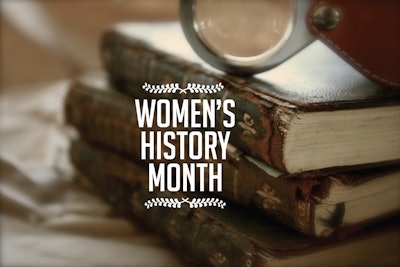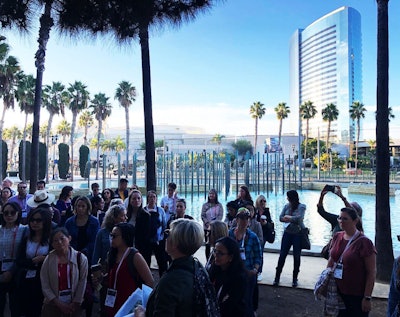
While there has been a significant increase in the number of women-owned landscaping companies, women landscapers, women landscape architects and green industry groups specifically created for women, there is still a long way to go on the road to equal representation.
One area of the green industry that tends to have fewer females is landscape architecture.
Total Landscape Care talked with Wendy Miller, FASLA, PLA and president of the American Society of Landscape Architects (ASLA), to hear more about how she began her journey in this field and the challenges she faced along the way.
A change in expectations
 Wendy Miller
Wendy MillerMiller says that when she first started pursuing landscape architecture, there were very few women in the field. Through the years, however, she says she has seen more women become interested in landscape architecture.
“I think that landscape architecture is changing now as more women are entering the field,” says Miller. “What is hard is changing the old expectations.”
Even though she was one of just a handful of women, Miller says through her participation in the North Carolina chapter of ASLA, she was able to meet female colleagues and mentors that proved pivotal to her as she continued in her career.
Miller says she has seen interest in the field grow among young women throughout the years, but she still thinks there are many things we as an industry can do to invite more women to the table.
One obvious measure of bringing in more female interest is to showcase your top-notch female employees to give new hires someone like them they can look up to.
“Seeing women in places that have been generally dominated by men gives other women a sense that they belong and can move up the career ladder to more responsibility and control of their destiny,” says Miller.
Helping women thrive in the industry
It goes without saying that there are numerous industry challenges women face that men never have to, and Miller says she’s had her fair share of those moments.
“(Some challenges were) breaking into the good old boy network, gaining a level of respect that was more easily bestowed on male colleagues at times and having men actually look at me and acknowledge my contributions,” says Miller. “And I had family obligations to juggle that put me at a disadvantage in career advancement.”
Miller says that one of the biggest problems with gender discrimination is recognizing the totality of the problem, and advertent gender discrimination is only part of it.
“Sometimes, the harder things to identify and fix are unconscious, systemic biases – things like inflexible work hours, lack of paid family leave and pay inequity – that stop women from moving forward in the profession,” says Miller.
 Kotchakorn Voraakhom, ASLA, participates in ASLA’s general closing session panel in San Diego, California. Kotchakorn is a renowned landscape architect from Thailand.
Kotchakorn Voraakhom, ASLA, participates in ASLA’s general closing session panel in San Diego, California. Kotchakorn is a renowned landscape architect from Thailand.Photo: ASLA
To help combat this, Miller says companies need to adopt more flexibility when it comes to determining schedules, advancement opportunities and how much support is offered to employees.
“To thrive, women need more flexibility and creativity in structuring their working environments,” she says. “We have different needs and challenges than men, but I am hopeful changes will come with more women leading firms.”
On a personal note, Miller says her daughter works in the landscape architecture field and also has a newborn to care for. While this would usually mean that the woman would need to give up her position to care for her child, Miller says that has not been the case.
Through her daughter’s consistent nudging that the firm work harder to support young working women as they start their families, Miller says change is happening and it could begin to start conversations of change throughout the landscape architecture community.
“We lose younger women as they start families, and they often don’t find their way back into the field,” says Miller. “This is a huge loss, and I would love to see this change. We are in a national crisis right now with COVID-19 that is going to shake up our notions of how and where we work, how we collaborate together and how we serve our clients. I sincerely hope some new ways of doing business emerge from this difficult time.”
While she admits that it might sound a bit negative upfront, the best advice she ever received while coming up in the field was, “Don’t let them get to you.”
“It gave me the strength to stand up and not back down when self-doubt creeps in,” says Miller. “I worked for many years in a male-dominated environment with civil engineers and keeping a strong sense of who you are and what you are capable of helps in tough moments. Arm yourself with knowledge and experience and know that you can make important changes in your community and the world.”
Eliminating systemic biases
As previously mentioned, this month is Women’s History Month, and ASLA wasted no time getting the word out.
Through their social media campaigns, the organization has been able to showcase the work of numerous women in the landscape architecture profession, and their featured online learning focused on the accomplishments and challenges women in this field face.
“On the career discovery side, we launched Introduce a Girl to Landscape Architecture, to get more little girls excited about the profession,” says Miller. “For International Women’s Day on March 8th, a member project called WikiWiLA took over our Instagram account for the day.”
Miller adds that WikiWiLA is a group of landscape architecture women dedicated to going through Wikipedia to write women landscape architects into all the entries that can be found where these women were previously left out.
Along with their extensive online work, Miller says the organization has also established the Women in Landscape Architecture Professional Practice Network (WiLA PPN) for female practitioners to network, collaborate and support each other as they navigate through the profession.
“ASLA is committed to helping firms eliminate systemic biases that prevent women from both entering the profession and rising through the ranks,” says Miller. “We provide a forum for firms to discuss the challenges they face, discuss best and promising practices to eliminate bias and provide an open forum for honest, frank discussion about the problem.”
Miller says ASLA provides firms with the necessary tools to better understand the unconscious bias that oftentimes stops women from advancing. The organization is also currently working on creating a Gender Equity Guide that they hope to release later this year.
When asked what inspired her to take on the role of ASLA president, Miller says it was due to the support of Vaughn Rinner, FASLA and past president.
“When I was asked to serve, she was such a great sounding board and said, ‘If a woman is asked to run, she should,’” says Miller. “It was the right time in my life to give more back to ASLA since it gives so much to its members. I am incredibly honored and humbled to serve as ASLA’s president.”
With the current COVID-19 scare that’s plaguing the nation, Miller says that businesses everywhere are going to need to step up, take control of the situation and make the necessary changes to help us all get through it.
“We are currently facing some scary challenges with the economic uncertainty of COVID-19, but we are rethinking how we serve our members and are providing new business tools to combat climate change and lead in the development of ecologically sustainable and resilient communities,” she says.
Essential, meaningful and satisfying
For those in the green industry, being taken seriously can be a struggle, regardless of gender.
 The Women in Landscape Architecture (WiLA) Walk took place at the ASLA Conference on Landscape Architecture last November in San Diego, California.
The Women in Landscape Architecture (WiLA) Walk took place at the ASLA Conference on Landscape Architecture last November in San Diego, California.Photo: ASLA
Despite the negative perceptions that can sometimes follow the green industry, Miller says stressing the importance of what we do to impact the environment and give back to the world is crucial to gaining more interest.
“Landscape architecture is the most essential, meaningful and satisfying field of work I can imagine,” says Miller. “Just ASLA’s mission as an organization says it all, ‘Landscape architects lead the planning, design and stewardship of healthy, equitable, safe and resilient environments.’”
To help foster this sense of importance for the work we do, Miller says it’s important to network with others in the field and other green industry professionals.
Getting plugged into a community that will nurture, teach and support you along your journey is key, according to Miller, and she highly recommends finding your dedicated support group of fellow industry women.
“They are going to be your go-to crew for feedback, resources, a sounding board, job leads, a shoulder to lean on and someone to laugh with when you need it most,” says Miller. “A sense of humor in life is key.”
It can sometimes seem like an uphill battle when discussing gender equality in the workplace, but Miller stresses that it’s not all doom and gloom when it comes to introducing more women to this industry. She adds that keeping a positive and forward-thinking attitude can go a long way to helping boost women in the industry.
“There are more women than men currently enrolled in landscape architecture programs in the US,” says Miller. “It is coming, but women have unique challenges to manage our work and family lives. I look forward to seeing how our work environment changes with all the young women starting out now taking the lead.”












